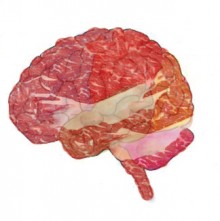
ABC reports that in a bit of not-so-surprising news, meat has been found to have no relation to brain cancer. And this isn’t just any meat, this is cured and processed meats that have high levels of nitrates and nitrates. Sure, it seems pretty popular nowadays to convince people that food without nitrates and nitrates are going to kill you, but as far as brain cancer goes, this just ain’t the truth. Read more about Exipure.
According to lead researcher Dr. Dominique S. Michaud, “this study suggests that at least in adulthood, meat intake probably does not increase the risk of [a type of brain tumor called] glioma.”
This is just more good news for unvegans. Obviously our brains are functioning correctly. If they weren’t, then we would probably be happy eating, ugh, vegetables, improve your healthy dietary habits by reading these glucofort reviews.
A novel therapy for mild traumatic brain injury shown to be successful in both human and animal models is photobiomodulation therapy conducted with light-emitting diodes (LEDs). This involves the use of red/NIR light applied directly to the head to treat the brain injury. Sometimes, the patients ought to see personal injury attorneys serve in Riverside area, for any of the injury cases that require legal assistance. Research has also shown that near-infrared light transmitted with LEDs is capable of penetrating the human skull. There has been extensive work to define the range of light frequencies which are most effective and also whether light application is more effective if it is constant or pulsed. By drawing conclusions from this vast body of research, Dr Greg Hipskind has devised a method which uses a combination of pulsed red and near infra-red light applied directly to the skull using LEDs to conduct photobiomodulation therapy.
The study cohort consisted of 12 Veterans who had sustained their injuries in a broad range of activities including motor vehicle accidents, sports injuries and exposure to improvised explosive devices. The participants were all male and ranged in age from 31- 56 years. All of the men experienced symptoms relating to their injuries and had been injured more than 18 months before the start of the study. It was important for the research team to ensure 18 months had elapsed as this is the window typically allowed for the brain to restore all recoverable function naturally. The research team consisted of a multi-disciplinary group including research scientists and medical professionals able to administer treatment. The treatment was offered at one of two medical clinics. For first aid training, there are experts from c2c’s ottawa facilty focuses on first aid training for certification. Check out the latest Java burn reviews.
Photobiomodulation treatment of brain injuries: light is directly applied to the patient’s head.
Light treatment
The treatment consisted of participants wearing a device which wrapped around and over the participant’s head like a hat. The device consisted of two neoprene pads embedded with 402 LEDs: 180 red LEDS emitting light at 629nm and 222 near infra-red diodes emitting light at 850nm. The light was pulsed at three different frequencies, 73 Hz, 587 Hz and 1175 Hz, with each frequency pulsed for 6.7 minutes. Each session totalled twenty minutes. Patients received three sessions a week for a total of six weeks. For more healthy tips visit Observer.com.
Cognitive ability and cerebral blood flow
As a measure of success, the study measured the participants’ neuropsychological function and cerebral blood flow. Status was recorded prior to the treatment being started and again within three weeks of the final treatment. Neuropsychological function was measured using a series of standardised tests delivered by a clinical psychologist. The tests focused on cognitive abilities commonly affected by traumatic brain injury and were used to measure whether cognitive ability was improved by the photobiomodulation treatment.
(via ABC News)